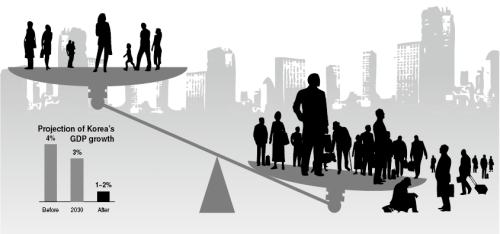Coming wave of retirements may cause economic disaster for Korea
ByPublished : Aug. 9, 2011 - 19:25
Experts call for measures to ensure more flexible labor markets, boost birthrate
To mark the 58th anniversary of its establishment on Aug. 15, The Korea Herald is publishing a series of articles on the looming retirement of Korean baby boomers and its socioeconomic impact on the nation. The following is the third of the eight-part series. ― Ed.

Korean economists and government policymakers expect that the baby-boom generation’s massive retirement in the coming years to sharply decrease domestic consumption, a critical blow to the nation’s economy.
The National Statistical Office said in a recent report that the baby boomers and the quickly aging Korean population are expected to weaken economic growth and widen the income gap.
Baby boomers, mainly born between 1955 and 1963, have been the major drive force in the nation’s economic development by boosting demand for domestic consumption in education, housing, labor and other markets.
Currently, there are 7.12 million baby boomers, accounting for more than 15 percent of the population.
“As most of the baby boomers are expected to retire before 2020, the population aged between mid-30s and mid-50s, a bracket with house-purchasing power, will start shrinking soon,” an NSO official reported.
“Considering the expected fall in productivity, plus weak consumption and investment, the situation would be very serious,” said a director-general of the Bank of Korea.
Citing the report, tilted “the impact of demographic changes on economic growth from the central bank’s Institute for Monetary and Economic Research,” the BOK official said the aging problem will slow the nation’s yearly economic growth to 3 percent by 2030.
He also forecast that the nation could see its average growth rate fall to the 1 percent level after 2030.
“The rapidly aging population is expected to become the main culprit of the nation’s stagnant economic growth in the coming years,” he said.

The BOK report advised that to counter the problems stemming from the drastic demographic change Korea needs a development strategy which would put more emphasis on enhancing productivity than simply increasing the workforce.
“Policy measures intended to encourage more workers to participate in the labor market including extending the retirement age would not be as effective as we anticipated in lifting economic growth,” the report said.
It also said policy options should focus on enhancing the nation’s competitiveness in the global market by revamping the education system and bolstering research and development.
The BOK report came as many have called for the government to cope with the diminishing growth potential stemming from structural problems such as a drastic demographic change and sluggish corporate investment.
Economists stress that the low birthrate, coupled with a population that is rapidly aging, is a source of serious long-term concern for the economy.
The Ministry of Strategy and Finance is working on a new set of measures that would include providing several types of financial assistance to parents with many children and female workers to help boost the birthrate.
The ministry is considering lifting regulations in the metropolitan area surrounding Seoul to induce corporate investment.
The nation’s birthrate fell to an all-time low in 2004, according to state data. The number of births in 2004 was 476,052, down 17,419 from a year earlier. It was the lowest since 1970.
According to the NSO, Korea has the most rapidly aging society among the 30 Organization for Economic Cooperation and Development members.
The state-run agency also stressed that Korea falls within the United Nations’ forecast of becoming a “super-aged society” by 2026, where people 65 years or older account for more than 20 percent of the population.
Korea became an aging society in 1999 when people aged 65 and older exceeded 7 percent of the population.
The average potential growth rate fell sharply to the 4-percent level between 2000 and 2010, down about 1.5 percentage points from that of the 1990s.
The potential growth rate is an estimate of the economic growth a country could attain without causing inflation.
The central bank also forecast that Korea would possibly face a shortage of up to 4.8 million workers by 2020 should it fail to significantly improve labor productivity in the service industry.
According to the bank’s report on economic structural changes in the long term, the service industry will account for 63.4 percent of all jobs in the next 15 years, led by rapid expansion of knowledge-based sectors such as electronics, communications and finance.
The manufacturing industry would still account for about 50 percent of the national economy.
The proportion of service industry employment is also unlikely to change significantly, inching only 2 percent over the next eight year period to a projected 38.2 percent of 2020.
However, while labor productivity in manufacturing industry improves 4.7 percent every year, that of the service industry has risen only 2.2 percent on average.
“If labor productivity does not increase significantly, the shortage of workers will become the biggest challenge that Korea faces in attaining further economic growth,” a BOK economist said.
He said the economy will need as many as 6 million new workers. “But labor supply will fall far short of the demand due to fast-aging population and world’s lowest birth rate.”
The NSO said that only 1.2 million people are projected to join the labor pool by 2020.
Private think tanks say that long-term fiscal issues such as the low birth rate and an aging population, both of which can threaten fiscal soundness, should be taken into serious consideration.
“Increase in pension and medical costs associated with the increase in the aging population will put more fiscal pressure on the government,” the Samsung Economic Research Institute reported.
SERI emphasized that the government should learn from Greece, and overhaul its fiscal policies, including cutting spending.
The crisis in southern Europe is stressing the importance of fiscal soundness, it said.
The Korean government is targeting a balance in 2014, and it should make sure that the aim is achieved, according to the report.
Hyundai Economic Research Institute advised the government to consider various measures to increase tax sources, which include introducing a green tax or raising taxes on cigarettes.
It also advised the government to consider privatizing state-run businesses.
“When considering the deficit that grew while overcoming the economic crisis and the possible risks following the general aging of society, it is crucial to restore fiscal soundness as soon as possible,” the Korea Institute of Public Finance said.
Recognizing the urgent need for action, the Ministry of Health and Welfare has taken a concrete step to prepare for the demographic shift.
By 2020, projections suggest that over-65-year-olds will have overtaken the under-14s in Korea and the size of the total population will begin to shrink.
And by 2026, the number of over-65s will have passed the 20 percent of population mark, making Korea a country of what United Nations experts have dubbed the super-aged society.
Life expectancy is also increasing. In 2005, an average Korean lives till 77.9 years old, more than a year longer than the OECD member countries’ average of 76.2. By 2050, it is expected to reach 83.3 years.
By Kim Yon-se (kys@koreaheraldm.com)



















